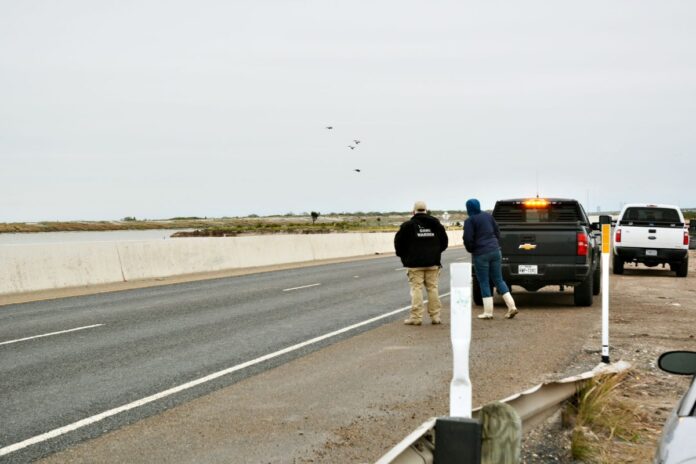PORT ISABEL — The carnage from last week was still visible, two brown pelican carcasses on the side of the highway serving as mementos of the two dozen birds killed by traffic at the Gayman bridge last week.
Conditions yesterday closely mimicked those of a week ago, with strong, gusting north winds of 25 to 35 mph under dark gray skies, and sharp pellets of rain coming in sideways.
“It doesn’t look like it’s going to be that bad,” said Lianne Koczur, a wildlife biologist who is doing post-doctoral work at Texas A&M University and was hired to study pelican deaths by TxDOT. “The wind looks like it will back down a bit as the day goes on. We’ve been watching them flying over the highway here and they seem to be making it across fine.”
Just a single pelican was a traffic victim yesterday, and Koczur was taking measurements of the bird’s carcass for her research.
“Nothing like last week,” she added.
The volunteers last week managed to save an estimated 150 to 200 birds by carrying them across the highway to the other side of the Carl “Joe” Gayman Bridge and out of danger. As of 3 p.m., there was little to do yesterday, other than to watch anxiously as the heavy pelicans lumbered north as they flew over the bridge into Bahia Grande.
Ready to help
Darrell and Dawn Young were among the volunteers helping yesterday, working with the U.S. Fish and Wildlife Service out of Laguna Atascosa National Wildlife Refuge.
Darrell said he and Dawn are both retired Air Force, “So we decided to start doing the full-time RV thing and volunteering where we can to help out.”
“It’s a chance to give back to the environment,” Dawn said, adding they were given instructions on how to proceed at the Gayman bridge site.
“That was a big, huge one — stay safe,” said Dawn, who was driving a U.S. Fish and Wildlife Service pickup. “This road is so fast already and then there’s the possibility of pelicans coming down like missiles. We’re really waiting for the police to show up to shut down a lane, and we’re just trying to slow the traffic down by driving slow.”
The Youngs are part of the “Pelican Team” of volunteers which mobilized last week, serving alongside the Department of Public Safety, U.S. Fish and Wildlife Service, Texas Parks and Wildlife Department, Texas General Land Office, Texas game wardens and the Port Isabel Volunteer Fire Department.
Why form the team?
The impetus for the team’s formation came one year ago, when two cold fronts tore through the Rio Grande Valley, taking their toll on the pelicans along the gulf coast. Between 60 and 100 birds were killed by traffic along State Highway 48 in twin massacres.
Along the cut between Bahia Grande and the Brownsville Ship Channel yesterday, a dozen die-hard men and women looking as if they dressed for ice fishing watch their rods in holders planted along the canal.
From a nearby marsh, curlews and glossy ibis rise and whirl away on the cold winds, only to spin again and alight back where they started.
Why it happens
The bridge over the cut between the Brownsville Ship Channel and Bahia Grande is a natural pathway for flying pelicans seeking to land in the bay.
But the three-foot high concrete barriers on both sides of the highway, plus the barrier separating northbound and southbound lanes, creates a strong vortex or downdraft when heavy winds are from the north. This effect pushes low-flying pelicans down onto the roadway, where they are vulnerable to traffic.
Above the bridge yesterday, gulls and terns transiting from the ship channel to Bahia Grande show no problem with the downdraft which plagues pelicans, because they are neither as heavy as the pelicans nor do they fly as low.
Changes coming
Since last year’s bird kill, TxDOT has been working to alleviate the threat to pelicans, including posting flashing hazard signs warning of “pelicans on roadway” along the highway and commissioning studies to try to find a balance between saving pelicans and maintaining safety for motorists on State Highway 48
“We’re working on a project funded by TxDOT to examine the daily movements of pelicans in the area,” said Koczur, the TAMU wildlife biologist. “This is where a lot of the collisions have been happening with vehicles during the bad weather events.”
Remnants
Evidence of last week’s pelican kill are on the side of the roadway just north of the bridge, the feathers of the dead birds still ruffling in the strong wind. Great-tailed grackles jockey for position, or dominance, astride the twin carcasses.
As a small flight of pelicans approaches the bridge, volunteers watch anxiously as the birds fight the north wind, losing altitude as their flight stutters as they reach the center of the bridge, then regaining their balance as they cross the highway to the other side.
The flight of seven birds lands safely in the Bahia Grande.
In the past two years, hundreds of brown pelicans have been killed at the site by vehicles. The bridge over the cut between the Brownsville Ship Channel and Bahia Grande is a natural pathway for pelicans seeking to land in the bay.
But the three-foot high concrete barriers on both sides of the highway create a strong vortex or downdraft when winds are from the north.
This effect pushes low-flying pelicans down onto the roadway, where they are vulnerable to traffic.




